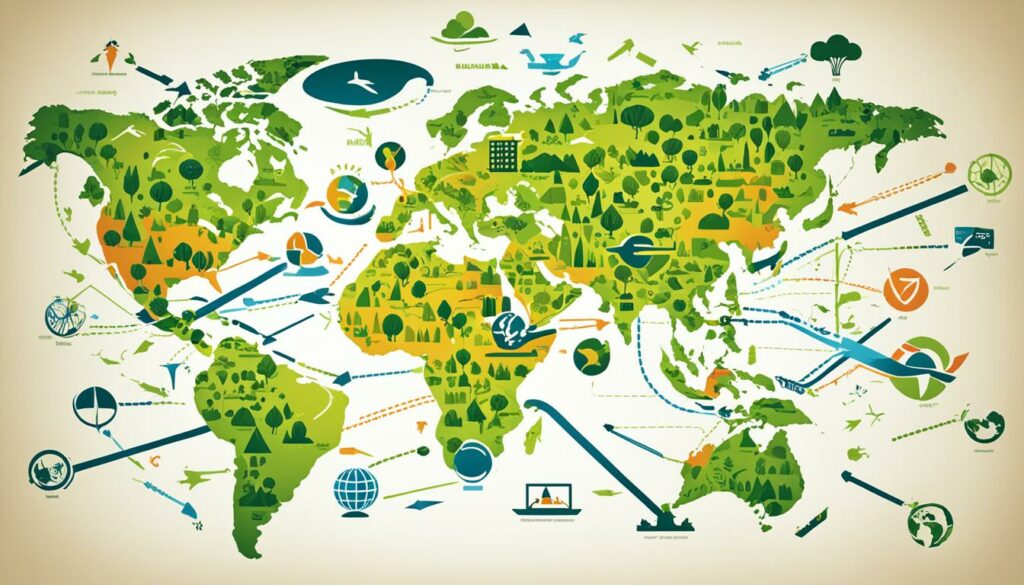Menu

Did you know U.S. exports made $2.35 trillion in revenue in 2014, supporting 11.3 million jobs? This shows how vital it is to boost export activities. It’s key for both developed and developing countries’ economic strategies. International trade campaigns and global outreach methods don’t just grow the economy. They also boost customer interest, loyalty, and open new market doors.
Export promotion plans encourage selling goods abroad. They can be direct or indirect, like using government help, trade policies, and special zones for exports. Making these strategies work well needs checking which policies actually helped before. We also must stick to WTO rules and use government support like financial help and smart marketing.
Looking deeper, it’s clear how key researching global demands, building networks, and adapting to different cultures are. These steps can make a company succeed worldwide. It’s also vital to use tech to bridge distance gaps and make sure to follow local laws when offering services outside your home country.
Export promotion strategies help countries boost their economy by selling more goods abroad. These policies are a key part of how governments plan to grow their economy. They help businesses enter new international markets.
To sell well abroad, companies need smart export marketing plans and good sales approaches. In a world where many companies are trying to sell the same things, it’s vital to know how to price your products. You can set prices in many ways, like matching the local price, undercutting it, or setting a premium.
When deciding on a price for your product to sell overseas, you must think about all the costs. These include marketing, production, shipping, and customs. Understanding the pricing and costs involved is key to winning in global markets.
It’s crucial to remember that selling goods is different from selling services in other countries. Goods usually need a strong start, while services benefit more from building local relationships. Vendors must also consider cultural differences, local media, and government rules when selling internationally.
The 47th issue of the Journal for the Advancement of Developing Economies shows how crucial good promotional strategies are for exports. It stresses the need for a strong export marketing plan.
Korea and Taiwan are shining examples of countries that grew their economies fast with good export strategies. In the 1960s, their growth rates were over 10% and 9.1%. This amazing growth was mainly from selling more goods around the world.
Looking at the connection between history, policies, and business practices, it’s clear that smart export strategies can change the game. The more we understand about export promotion, the more we see its huge potential. By using these strategies, both nations and companies can grow their businesses globally. This leads to ongoing economic progress and success.
Government steps in when the market fails. It does this to fix problems and make economies better. Theoretical reasons show why this is important. They help make plans to boost exports work well.

Marshallian externalities tell us why helping new industries is important. Governments support these industries to grow, bringing competition and new ideas. This help is vital in the early stages to then export more.
Problems in the market come from not sharing information and not working well together. Governments help by making export plans smarter. This way, firms can work better with foreign markets. It makes exports stronger and more efficient.
Giving firms a leg up to find what they’re best at is key for governments. They invest in finding new sector opportunities through research. This smart use of resources helps grow areas where a country can do really well.
By creating knowledge-sharing and learning opportunities, governments help everyone. Strategies that focus on building skills and sharing new technologies help a lot. They boost everyone’s productivity. This makes countries stronger economically, making their export market bigger.
| Country | Export Promotion Policies | Financial Incentives |
|---|---|---|
| Argentina, Brazil, Mexico | Tax refund schemes, EPZs | Credit export agencies, export credit lines |
| Ghana, Kenya, Nigeria | Incentives for export activities, EPZs | Support for FDI in export activities |
Good export promotion policies are key for making a country’s economy better. They include things like giving money for exports, creating areas for special export work, and helping with financial deals. Trade groups are also very important. They help connect goods to buyers both at home and abroad.
In 2021, the United States saw exports make up over 10% of the yearly economic growth. This was about $2.6 trillion. Most exporting businesses are small or medium in size. This shows the need for easy financial help and advice from trade groups.
| Country | Top Exports | GDP Growth Impact |
|---|---|---|
| United States | Refined Petroleum, Cars, Integrated Circuits | Supported 9.9 million jobs annually |
| Taiwan | Electronics, Machinery | GDP growth from 5.5% to over 10% |
| Korea | Automobiles, Ships, Electronics | GDP growth from 4.4% to 9.1% |
Taiwan and Korea have seen big economic boosts from exports. Between the 1950s and 1960s, Taiwan’s economy grew from 5.5% to over 10%. Korea’s economy jumped from 4.4% to 9.1%. They did this by building things like roads and offering loans at good rates.
Spending on making exporting easier and offering money has helped a lot. Countries like the Asian Tigers, Taiwan, Korea, Malaysia, and Singapore, grew fast this way. They moved from just buying things to selling a lot overseas. This made life better for many people, cutting down on poverty.
Creating strong trade groups and smart ways to help with deals is vital for exports to do well. Policies that aid exporters really help the economy and jobs. This is why having good plans to support exports is so important.
Trade finance is a must for exporters eyeing global markets. It involves many financial tools to help export activities. These tools protect from risks in international trade.

Trade finance includes great tools like Letters of Credit (LCs) and Bank Guarantees. These help in making international trade less risky. LCs, for example, ensure exporters get paid, even if markets change.
Finding the right trade finance for your business is very important. Having good relationships with banks is smart. Making sure your trade documents are accurate is also vital for safe and smooth trading.
Export credit agencies (ECAs) also help exporters by giving financing and insurance. They are often supported by their governments, offering better terms. The Small Business Administration (SBA) in the US helps small businesses export by guaranteeing loans. In FY 2015, the SBA backed $1.45 billion in loans, showing how ECAs boost exports.
More lenders are offering finance solutions from 430 to 555 between 2014 and 2015. This growth in support is also seen in more small businesses using SBA loans for exporting. The number rose from 1,326 in FY 2010 to 1,513 in FY 2015.
| Year | Number of Lenders Providing Export Loans | SBA-Guaranteed Loans ($ Billion) |
|---|---|---|
| 2010 | 430 | 1.326 |
| 2014 | 514 | 1.480 |
| 2015 | 555 | 1.45 |
The above data clearly shows growing support for exporters. By using trade finance and ECAs, businesses can take on less financial risk in global trade. This helps them succeed internationally.
By the mid-1980s, over 40 export processing zones (EPZs) were in Asia. They employed nearly half a million. Developing countries made these zones to get money through foreign exchange. They also create jobs and bring new technologies.
EPZs help in making a variety of products for export. They do this when a country is just starting to grow its industries. This helps the country sell more types of products to other places.
EPZs are like special places for foreign companies. They get special treatment on things like bringing in materials, taxes, and not following all the rules. This makes companies want to move there. They can then make different things to sell to other countries.
In EPZs, companies can bring in materials for making products without paying taxes. They don’t pay some taxes on the money they make. Also, they face less red tape, get help with buildings they need, and lower bills for water and power. Companies in EPZs are allowed to own their businesses fully and can easily take out their profits. They can also hire people from other countries and bring in big machines to work with. These are all big reasons why EPZs are good places for companies to invest in and grow their export businesses.
In EPZs, companies make products that go to other countries. They use materials, machines, and workers from both inside and outside the EPZ. Local workers get paid and trained while the company makes its products. This helps the area by offering jobs and teaching new skills. However, in the beginning, these places don’t increase how much the country sells to others by much. They do get better over time at helping the country sell a wider range of products.
| Features | Benefits | Impacts |
|---|---|---|
| Duty-Free Imports | Low production costs | Increased attractiveness for foreign firms |
| Tax Holidays | Higher profit margins | Sustained foreign investment |
| Streamlined Administration | Efficient operations | Boosted productivity |
| Subsidised Utilities | Reduced overheads | Enhanced competitiveness |
Trade Promotion Organisations (TPOs) help companies boost their exports. They give businesses valuable info about foreign markets. This way, they make it easier for local producers to connect with overseas buyers. Their work is key in increasing export sales.

TPOs do a lot to support global trade. They offer help, choose what products to push, and find new places to sell. They also help with trade events, set up business meetings, and arrange deals. Using online tools is now very important, especially for small businesses aiming to go global.
In richer countries, TPOs have much bigger budgets than those in poorer nations. During COVID-19, these richer TPOs both grew their budgets and improved their management structures. This shows they are more efficient.
PROEXPORT Colombia and APEX Brazil are shining examples. They have helped their countries sell more abroad. The Network of Trade Promotion Organisations in Spain also does a great job by getting members to share ideas. This boosts everyone’s exports.
In Latin America, TPO efforts stand out. They help their countries sell more diverse products overseas. This spreads the risk and grows the economy. EXPORTAR in Argentina, CEPROBOL in Bolivia, PROCHILE in Chile, and PROMPEX in Peru are solid examples.
Working together, TPOs in the Caribbean and Latin America achieve a lot. They boost trade and help make more goods and services. This helps the whole region grow and handle economic challenges better.
Embracing digital export efforts is crucial now. Over 2 billion people worldwide are online. By 2030, PwC predicts two-thirds of the global middle class will be in Asia. This means a wide market for businesses. They need smart digital strategies to target these users.
Now, social media offers big chances for exporters to connect with people worldwide. The Export Digital platform helps by offering around 100 video tutorials. These focus on online marketing and export issues. They empower businesses to use social media well, attracting new customers. This platform also enhances customer service and communication, vital parts of a strong export plan.
Setting up online is essential. It lets companies see what products customers want. It also helps boost E-commerce sales. The Export Digital platform supports Swiss SMEs in this area. It provides training and shows how to use online marketing tools.
Also, it has a sales markets locator. This feature helps businesses know where their products stand against competitors. Through AdWords, they learn about competitive campaign prices.
Success in digital exports comes from mixing digital channels with a wider business strategy. This strategy should also include working with partners and using traditional methods. It is vital to consider cultural and regulatory differences in new markets. By creating a strong online presence, businesses build a platform for real interaction with their customers. This understanding is key in targeting various customer types successfully.
Engaging in cross-border selling tactics is a must for businesses aiming to grow. The cross-border ecommerce market is set to hit nearly $8 trillion by 2030. This shows there’s huge growth potential for those who venture abroad.
Using smart tactics helps companies reach new international customers easily. It also helps diversify risks and avoid depending on one market. Selling in different countries lessens the impact of local market changes. It also helps avoid seasonal sales drops by finding demand in various parts of the world.

Getting into new markets early can give a big edge. It lets businesses grab a share of the market before their rivals. There’s strong interest in online global sales. 66% of companies are planning to start selling internationally soon. 90% expect to have an international sales plan in three years.
Knowing and following rules about what goods can’t be sold, safety rules, and taxes is key. Having a smooth system for taking and sending orders is important for international success. Automation software can make things run more efficiently.
Shopify Plus is a platform that can make going global easier. It offers safety tools, follows the law, localised experiences, and joins with sending and handling packages. These are vital for companies wanting to reach more people and make more money around the world.
Here are some eye-opening stats about the importance of selling across borders:
| Statistic | Percentage/Value |
|---|---|
| Projected cross-border ecommerce sector value by 2030 | $8 trillion |
| Companies planning to start international sales soon | 66% |
| Businesses pursuing an international sales strategy within 3 years | 90% |
| Retail leaders considering international business crucial in 5 years | 88% |
If businesses learn and use cross-border selling tactics well, they can greatly increase their market share. They can also meet their international business goals.
Getting involved in trade show networking brings many benefits. It’s a key spot for businesses looking to enter new markets and build strong ties. Trade shows help firms boost their brand, learn from others in the industry, and form important relationships.
Trade shows bring together buyers, sellers, and key players. This speeds up how relationships and sales grow. The U.S., Canada, and Mexico host over 14,000 trade shows each year, making them a goldmine for understanding the market, spotting trends, and sizing up competition.
Getting the most out of networking at trade shows involves key strategies. Starting with careful event selection aligning with your goals. The International Trade Centre provides tools like contract samples and market data to guide your choices. Busy yourself at these events with meetings, demos, and promotions to make a bigger mark and earn loyalty.
| Key Benefits | Advantages |
|---|---|
| Increased Brand Visibility | Nurtures long-term customer loyalty |
| Cultural Insights and Competitor Analysis | Strategic improvement and product refinement |
| Personal Contact | Closes sales and builds client trust |
In the end, involvement in both {em}show networking and promotional events does wonders for a company’s global efforts and lasting prosperity. Smart participation and use of these occasions let businesses grow significantly and become prominent worldwide.
Promotional events greatly help brands get seen, especially in B2B marketing. They are very significant for generating leads and spreading brand awareness. So, they are really important for a strong marketing plan. 
Choosing the right trade show is vital for marketing success. The perfect event can speed up a company’s sales, massively increase brand visibility, and boost your marketing ROI. Planning big events far ahead increases your chances of success.
At these events, interactive displays and demos attract the audience. Good booths have fun contests and activities that attract people, which increases their interest in your brand. Giving away cool prizes like Bluetooth speakers, webcam covers, and power banks also helps.
Customising your content, like videos and blog posts, can really help generate leads. Using social media before and during the event can extend your promotional reach. It helps keep people interested even after the event is over.
Recently, events are becoming both in-person and virtual, reaching more people. For the best outcome, plan your B2B trade show events at least a year ahead. This gives you enough time to plan and execute well.
Visuals are vital for promo events. They can make your brand more memorable by 42%. As most people learn visually, using compelling visual features like branded balloons or AR/VR tech can make your event stand out.
It’s wise to integrate your event software with CRM for managing leads better. This helps keep track of follow-ups, making it easier to convert leads into sales after the event.
At trade shows, you can find new clients and get feedback to improve future promos. Using Trade Promotion Optimization Software helps track results in real time. This allows you to adjust quickly and see better sales.
When you run promotional events well, they boost your brand’s visibility and interaction. They help you make important business contacts and keep your market interested over time.
| Elements | Impact |
|---|---|
| Interactive Exhibits & Demos | Captures audience attention and engages potential leads. |
| Engaging Competitions | Draws visitors to booths, promoting brand engagement. |
| Visual Elements | Increases brand stickiness by 42%. |
| Social Media Integration | Amplifies event impact and extends audience reach. |
| Interactive Technologies (AR/VR) | Enhances visitor experience and engagement. |
| Prize Incentives | Increases booth footfall and visitor participation. |
Exporters need to know how to look for new markets efficiently. They should focus on markets that promise success and adapt their products to meet local needs.
To succeed in new markets, it’s vital to pinpoint where to aim. First, look at your current customers to find clues on where to expand. Then, aim your efforts at the most promising market segments. Reconnecting with past leads and sending reminders can reignite their interest.
Finding profitable niches is important for growing companies. This means figuring out who your best customers are and what they have in common. Also, always track your sales costs to make the best financial choices.
After spotting your potential markets, you must tailor your products for them. This could mean changing the product to match local tastes, buying habits, and economy. For example, changing how you incentivize your distributors can boost sales.
You also need to keep an eye on your prices. Make sure they’re competitive and affordable, factoring in local currency and income levels. This is crucial for success in new places.
Regularly reviewing your clients can show who’s not worth the effort. Shifting focus to more promising clients improves your effectiveness. Offering unique products in new markets highlights your dedication to customers and boosts your competitive edge.
For successful expansion, keep building on your competitive strengths. This helps you get the best profits and leads to a strong position in new markets. Adapting your products for local needs increases your chances of international success.
“Periodically assessing market trends and customer feedback can highlight areas where product modifications can significantly boost market acceptance and profitability.”
If budgets are tight, focus on expanding wisely. By making products that fit different markets and smartly expanding, exporters can grow sustainably. This approach helps in the tough global competition.
Export subsidies are important despite their complicated interactions with WTO rules. They are a key tool in a country’s market strategy. My research in the European Union, mainly in Denmark, Germany, and Spain, showed each country uses these subsidies to boost their global trade. I was impressed to see how they keep a balance between international rules and helping their exporters be more competitive.
Denmark has been using export promotion strategies well for the last 15 years. Germany, as the biggest European exporter, has strategically used export subsidies since GTAI started helping in 2009. Taking advantage of its ties, Spain has merged its export efforts into ICEX since 2012.
Looking at these three countries, it’s clear that export subsidies are vital for their market strategies. Ambassadors and civil servants in Denmark, Germany, and Spain have key roles in increasing these subsidies. They help open new markets. For example, the Africa Business Network aids German companies in entering African markets.
Germany’s partnerships and consultations are crucial for its export growth. The German Economic Team’s work has helped with stability and trade, boosting German exports. These efforts show how export subsidies, when part of a smart strategy, can greatly help export business.

In the EU, export subsidies are like a central piece in the export promotion strategies. Learning from Denmark, Germany, and Spain can help others improve their export efforts. Smart use of these subsidies not only boosts export but also brings steady economic growth through global strategies.
It’s key to measure how well export promotion policies work. This helps us see their real effects and find ways to make them better. The main aim is to figure out if these plans are successful and worth the cost. By taking a close look at them, we learn how they help the economy grow. Plus, we see what makes them work or not.
To check if export policies are doing well, we look at many things. These include more exports going out, selling to new places, and making local products better matched for the global market. Figuring out the return on investment (ROI) is important. This means we look at the direct and indirect gains from these policies.
Between 2000 and 2015, Ethiopia reviewed its work in making things sold abroad. The textile business did very well, but the leather sector didn’t do as good. This shows why policies need to be designed specially and implemented strong.
Studying these good ways gives us useful ideas. We can use them to make export policies that actually work. Looking at what others do not only guides us in setting smart strategies but also helps us use our time and money better in boosting world trade.
In conclusion, strong export promotion strategies are key to success in international trade. The experiences of Southeast Asian countries are key examples. They show how shifting to export promotion in the 1950s brought Taiwan and Korea more economic success by the late 1960s.
This change led to rapid GDP growth and helped reduce poverty. By the 1990s, countries like Korea, Taiwan, Malaysia, and Singapore had booming economies thanks to a focus on exports.
It’s clear that ongoing policy review is crucial. Things like government help and good infrastructure matter a lot. They help developing industries stand on their feet and grow.
Looking ahead, using trade finance is a smart move for export business. Things like export credits and aids are linked to better trade. They make it easier for exporters to deal with payment risks.
Moreover, working with Export Processing Zones and Trade Promotion Organisations is important. These partnerships help exporters market their products better. They aim to keep international trade success going strong.
Effective export promotion strategies are policies and actions. They aim to help exports, grow the economy, and expand a country’s trade globally. They include government help, special zones for exports, easier trading loans, and groups that boost trade.
These strategies help by making it easier for exporters to sell abroad. This increases sales and adds to the country’s income. They use perks, special trade money, export zones, and organisations to drive exports.
Sometimes, markets don’t work perfectly. In those cases, letting trade happen freely isn’t the best choice. To fix issues and support trade, governments can help businesses share info, find what they’re best at, and learn new things.
Marshallian externalities are benefits that businesses or people don’t see but get from others. For example, one company making a breakthrough can help other new companies grow. Protecting these new companies can make an economy stronger for the long term.
EPZs are special areas with tax breaks and simple rules to attract businesses. They encourage more exports and help a country’s economy grow and change.
TPOs link local exporters to foreign buyers. They do market studies, help with trade rules, and organise events that help sell more. This makes selling abroad easier and more successful.
Going digital, like using social media and a strong website, can help a business be seen globally fast. This can lead to more interest and sales worldwide.
Good tactics include knowing what global buyers want, using smart sales methods, adjusting products and how we sell them for different places, and using the internet to reach more people.
Trade shows let exporters meet future partners face-to-face, make their brand more known, and meet many potential clients in one place. This can create lasting business bonds and new export chances.
These events are great to launch new products, show how good you are at exporting, and make people interested in what you sell. They help get the word out and connect with important folks in the industry, helping exports grow.
Even with some rules against them, export subsidies matter. They help companies do well in foreign markets, reach their sales goals, and boost how much they export.
To check how well these policies work, we keep looking at their results and what they bring back. Seeing how others do it can help us make our strategies even better and more successful.